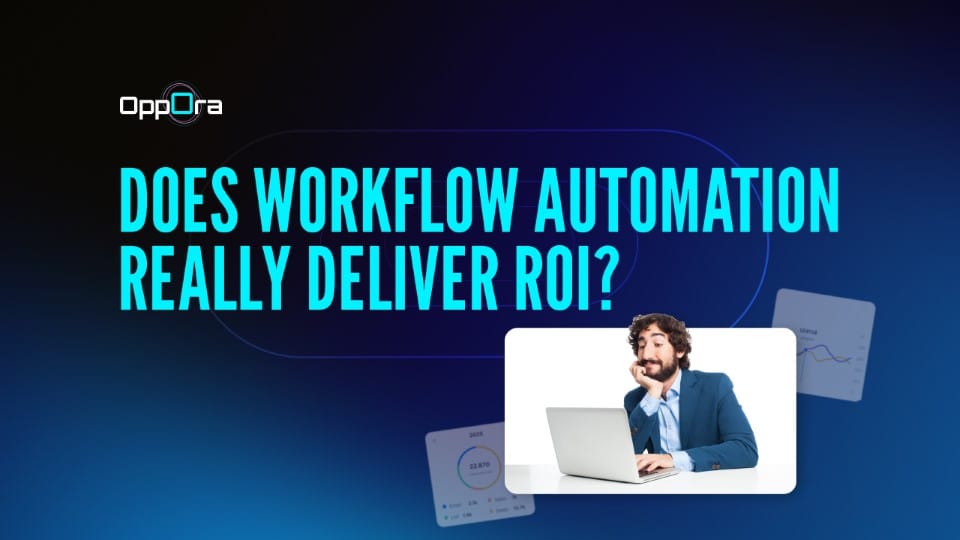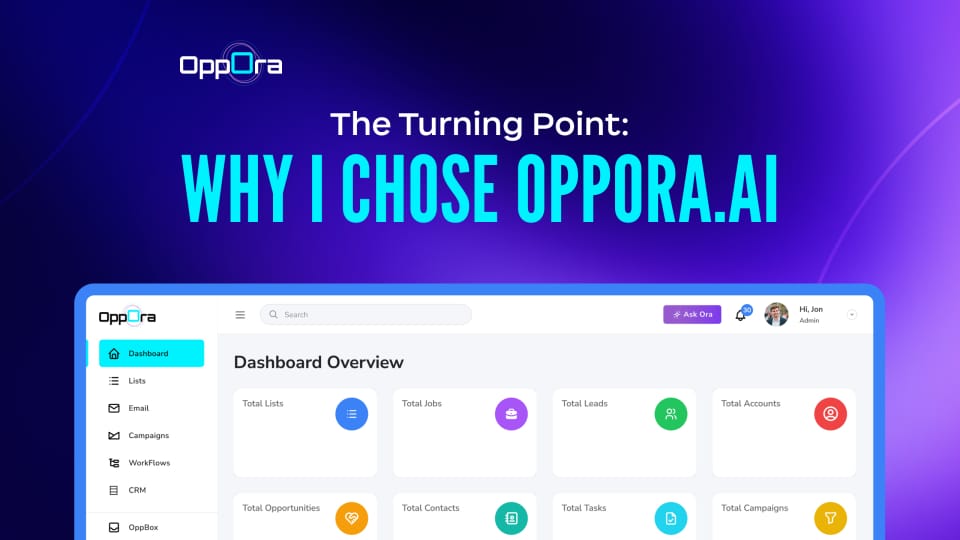Home
Blog
Tell Oppora who to target & it finds contact data, sends emails, and replies from your inbox automatically. Try our FREE forever Plan now.
Get startedHome
Blog

Every sales rep I’ve worked with has the same problem: too much time spent on manual work instead of closing deals. I know this pain myself. My mornings were filled with lead search, checking emails, and updating spreadsheets. By lunchtime, I hadn’t even talked to a single potential client.
The irony? We were hired to sell, not to be full-time admins. But like most sales people, we were stuck handling repetitive work and boring data entry. End of the day, we might have done dozen's of “tasks,” but the real sales process,building trust, finding opportunities, and closing deals,hardly moved forward.
"A McKinsey study confirmed what I saw every day: sales people spend 65% of their time on admin work and manual tasks instead of real selling【McKinsey, 2023】."
That means I was losing the most valuable resource of all-time.
I started asking myself: if we keep wasting time on manual work, how will we ever grow our sales funnel or serve customers well?
One evening, staring at a half-updated CRM, I asked myself a simple question:
👉 “What if the hours my team wastes on repetitive manual tasks could be spent talking to customers, building relationships, and closing deals?”
That single thought shifted my perspective. The issue wasn’t the sales reps. It wasn’t the marketing team. It wasn’t even the number of leads we had. The problem was inefficiency in our sales workflow automation-or rather, the lack of it.
We were stuck in an outdated way of working, where every step in the sales pipeline-from lead capture to sales proposals-depended on human effort. No wonder things slipped through the cracks.
That’s when I discovered the real power of sales automation.
The entire process changed. We weren’t just moving faster-we were moving smarter.

Now, you might be thinking: “Okay, this all sounds good. But does it actually pay off?”
I asked myself the same question before diving in. So I looked at the numbers:
And here’s what happened when I implemented Oppora.ai internally:
For me, that was all the proof I needed: workflow automation isn’t just cost-saving, it’s revenue-generating.
Let’s get practical. Sales workflow automation isn’t just about using a fancy CRM or sending bulk emails. It’s about designing an automated workflow that removes friction from the entire process of selling.
Here’s how I define it:
Think about it: instead of a sales rep wasting time on manual work like updating fields, setting reminders, or typing the same follow-up email, an automated workflow can handle these tasks in seconds.
For me, the real magic was that it freed the team to focus on what they do best-talking to customers, sharing solutions, and building relationships.
That’s why I chose Oppora.ai. It’s not just another sales automation tool-it’s built to connect sales tasks, marketing campaigns, CRM data, and customer interactions in one smooth flow.

At Oppora, I knew we couldn’t continue losing hours to manual lead search and fragmented systems. We needed a solution that could:
I considered big platforms like HubSpot Marketing Hub and Salesforce Marketing Cloud. They’re powerful, no doubt. But they felt bloated-built for enterprises with thousands of employees. For a fast-growing sales team, they often required more maintenance than they saved.
That’s when I Use on Oppora.ai. What set it apart was the focus on AI sales automation built for modern sales reps:
Oppora turned our messy sales process into a clean, scalable automated workflow.Also, they provide step-by-step knowledge on how to use it, so even new users can get started quickly and confidently.
👉 All in all, it’s the complete solution for startups, SMBs, and busy sales teams who want to save time, boost productivity, and scale without tool overload.
To appreciate the difference, let me walk you through a typical day.
Net result? Lots of “activity,” little progress. Maybe 2–3 conversations with a potential client.
Now, instead of drowning in administrative tasks, reps spent their valuable time where it mattered: the sales funnel.
One of the biggest wins was in sales productivity. Here’s why:
When I looked at the numbers, the productivity boost was undeniable." According to Salesforce, teams that adopt sales automation software see up to 53% higher conversion rates【Salesforce, 2023】."
For Oppora, that meant fewer lost opportunities and more deals closed.
Here’s the truth: automation is useless without good customer data. That’s why Oppora.ai puts data enrichment at the core of every automated workflow.
We synced with CRM software, cleaned duplicates, and enriched profiles with verified contact info. Suddenly, customer interactions were more relevant because reps had full context.
Good data made every sales proposal, every marketing campaign, and every customer experience stronger.
Another breakthrough was in sales engagement. Using tools like LinkedIn Sales Navigator together with Oppora, we automated the way we reached out to potential clients.
Instead of sending generic blasts, each campaign was tailored using AI sales automation. Oppora generated personalized sequences that made reps feel human at scale.
The result? More replies, warmer conversations, and stronger relationships.
The old saying used to be “sales blames marketing for bad leads, marketing blames sales for not following up.” With automation, that blame game ended.
Oppora connected our marketing team’s campaigns with the sales pipeline. Leads from campaigns flowed directly into automated workflows. Customer interactions were tracked in one place.
That meant sales reps didn’t waste valuable time chasing cold leads. They worked on qualified opportunities already warmed up by b2b marketing automation.
Finally, automation gave us something I didn’t expect: clarity in sales forecasting.
Because the entire process was automated, we had cleaner data and more consistent metrics. That made it easier to predict revenue, track opportunities in the sales funnel, and set realistic goals.
And this wasn’t just for managers-reps loved it too. They could see their pipeline, understand their performance, and plan their tasks without stress.
Here’s what I learned from Oppora’s automation journey:
Yes, there are risks:
But I learned to overcome them by:
A: It saves valuable time by eliminating repetitive manual tasks, allowing sales reps to focus on customer interactions and closing deals.
A: Even small teams gain huge value-automation reduces administrative tasks and boosts sales productivity without extra headcount.
A: No, it works best alongside a CRM by automating updates, enriching customer data, and keeping the sales pipeline clean.
Q4. Does automation hurt the personal touch in customer experience?
A: Not if done right-automation handles the repetitive tasks so reps have more time for meaningful customer interactions.
A: No,It frees sales professionals from manual work so they can focus on building trust, nurturing opportunities, and closing more deals.
A: Not always, but integrating with a CRM ensures customer data, activities, and pipelines stay clean and connected.
A: It aligns marketing and sales, ensuring campaigns feed directly into the sales pipeline with qualified, ready-to-convert leads.
A: By keeping customer data accurate and consistent, automation makes sales forecasting more reliable and less guesswork-driven.
A: The main risks are over-automation, poor data quality, and resistance from employees, but these can be managed with the right strategy.
A: It saves time, improves sales productivity, and creates a scalable sales process that grows with your business.
When I look back, the shift is clear:
That’s the real promise of sales workflow automation. It’s not about replacing reps-it’s about freeing them from repetitive tasks so they can do what they were meant to: build relationships, serve customers, and grow revenue.
And for us, the tool that made it happen was Oppora.ai.
Share it with your network and help others discover great content